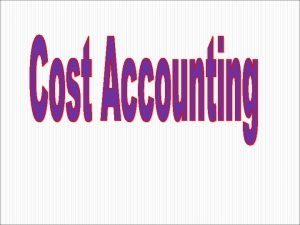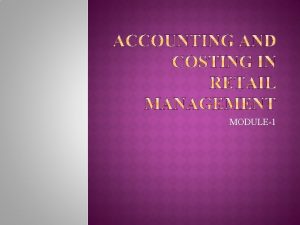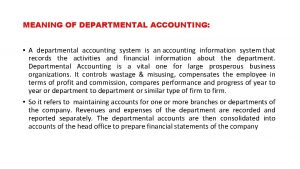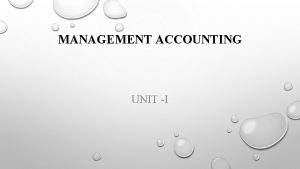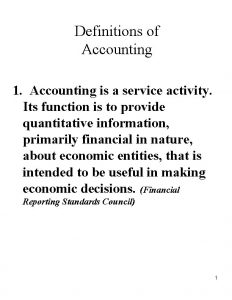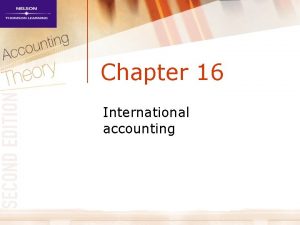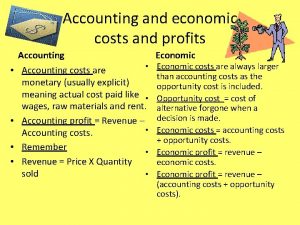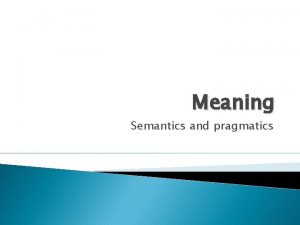Accounting Meaning and Definitions Accounting is the art




























- Slides: 28

Accounting- Meaning and Definitions • “Accounting is the art of recording, classifying and summarizing in a significant manner and in terms of money, transactions and events which are, in part at least, of financial character and interpreting the results thereof. ”

Accounting Cycle

Journal

Introduction “The Journal is a book of original entry in which are recorded transactions not provided for in socialized journals. ” --Eric. . Kohler “A Journal is a chronological record of accounting transactions showing the names of the accounts that are to be debited or credited, the amounts of debits and credits, and any useful supplementary information about the transactions. It is analogous, to a diary. ”

Features of Journal The following are the main characteristics of journal : 1. It is a book of original entry because transaction is recorded at first stage in this book. 2. It is also known as day book or diary because transactions are recorded in it-on day to day basis as and when they take place. 3. The Journal is only a subsidiary book, subordinate to the ledger which is the principal book of accounts.

• Contd. • 4. It keeps a chronological record of all transactions i. e. , arranged according to the o occurrence. • 5. The Journal gives a complete picture of each business transaction and thus, moil the identity of the transaction. • 6. Amount of transaction is recorded on both debit and credit columns side by ei helps in maintaining arithmetical accuracy of the books of account. • 7. The Journal reflects the relation that exists between two aspects (debit and involved in a transaction. • 8. Every entry in the Journal is followed with

Need for Journal • The transactions can directly be recorded in the proper accounts in the ledger hut procedure will be difficult and confusing, if number of transactions is large. Journal is needed in the following respects. • Convenient recording of the transactions • Maintaining and preserving the identity of the transactions • Ascertaining the true nature of transactions with the help of narrations: and • Maintaining permanent record of information.

Functions of Journal • Journal performs the following functions. . - • To maintain the identity of each transaction as a permanent source of information : • To analyze each transaction into debit mid credit, so as to enable their Posting in the ledger: and • To arrange transactions chronologically i. e. . in order of date.

Format of Journal The following is the specimen of Journal: Date Particulars 200 7 Jan. 1 Machinery Account To Cash Account (Purchase of Machinery for Cash) Dr. Ledger Folio Debit Amount Credit Amount 50, 000

Advantages of Journal • Journal is known as a book of original/prime record. Maintaining journal gives the following advantages to the entity concerned • (1) Transactions recorded date-wise with explanation. All business monetary transactions are entered in journal in chronological order occurrence. Thus, chances of omitting a transaction are reduced. Moreover, each entry carries brief explanation known as narration which makes understanding of the real meaning of the transaction at a future date easier. • (2) Process of classification at convenience. Since transactions are recorded in journal as and when these take place, it ensures that nothing shall be omitted which should be recorded. Process of posting into ledger can be scheduled at the convenience of the entity.

Advantages of Journal • (3) Ensures that double entry rules have been followed. Each transaction. before it is recorded in journal, is analyzed for the aspects involved: accounts to be debited and credited and also the debit and credit amount. Totaling of amount columns on each page ensures that the basic rule of 'debit having equal and corresponding credit' has been followed. • (4) Reliable evidence. As the transactions taking place and recording are at the same time, therefore, chances of cooking or manipulating the facts are minimized. Thought out alterations or insertions are not possible. Therefore. courts regard the evidential quality o journal much better as compared to secondary records, say, ledger. • (5) Sub-division enables division of labour. Now a days, most of the entities follow what is known as "Practical system of book-keeping". Under this system, more than one journal a maintained (system shall be discussed in a subsequent chapter) to record one type transactions in a separate journal, say, separate journals to record purchases, sales etc. , In sic a case, different sub-journals can be handled by different persons, thus, each person acquires the

Limitations of Journal • Journal suffers from the following limitations: • 1 - Long and unveiled. The journal will be long and unveiled, if the business has too many transactions. • 2 - Daily cash balance not possible. It is not possible to ascertain daily cash balance from journal. Separate book is to be maintained for this purpose. • 3 - Difficult to locate a transaction. It is difficult and time consuming to locate a transaction in the journal, if date of transaction is forgotten. • 4 - Time consuming posting. It is time consuming to post each and every transaction from the

Journalizing Proces • Journalizing Process • The process of recording a business transaction in the. journal in a systematic and scientific manner is called Journalizing. It is always done on the principles of double entry system. • “The process of recording a transaction in a Journal is called Journalizing the transaction. " • Melgs and Meigs and Johnson • “ The technique of writing a transaction in its twofold aspect with proper description in Journal is called Normalization. " • H. Chakarborty. • The form or manner in which a transaction is recorded in the journal is called ; Journal Entry;

Rules Under Traditional Approach at a Glance SNO Types of Accounts Examples Rules for debit Rules for credit 1 Personal accounts (a) Natural: Ram’s A/c Manjit’s account (b) Article: M/s Bindra’s& Bros’s A/c Raymond Mill’s A/c Khalsa College’s A/c (a) Representative: Wages Outstanding A/c Prepaid Insurance A/c Debit the receiver of benefit Credit the giver of benefit. 2 Real accounts (a)Tangible: Plant A/c, Building A/c (b) Intangible: Goodwill A/c, Copy Rights A/c Debit what comes in Credit what goes out 3 Nominal accounts (a) Expenses: Purchase A/c, Wages A/c (b) Losses: Loss by fire A/c (c) Profit & Gains: Profit on Sale of assets A/c Debit all losses and expenses Credit all gains and incomes

ILLUSTRATION 5. Some Specimen Transactions • (1) Amar started business with Rs. 5, 000 Cash account …Dr. To Amar’s capital account ( Being the Commencement of business with cash) 5, 00, 000 (2) Out of the above, Rs. 40, 000 are deposited in the bank. Bank account To Cash account ( Being Cash deposited in the bank) …Dr. 40, 000

(3) Purchased office Furniture for cash worth Rs 30, 000 Furniture account …Dr. To Cash account ( Being the Cash Purchase of Furniture) 30, 000 (4) Purchased goods for cash Rs. 15, 000 Purchase Account …Dr. To Cash account ( Being Cash Purchases of goods) 15, 000

(5) Sold goods for cash Rs 35, 000 Cash Account To Sales account ( Being the cash sales of goods) …Dr. 35, 000 (6) Received salaries Rs. 5, 000 Salaries account To Commission account ( Being the receipt of commission in cash) …Dr. 5, 000

Treatment of receipt on personal/Income account Received Rs 800 from Tarun on account Received Rs 800 from Tarun as commission The entries are: (1) Cash account To Tarun (ii) Cash account To Commission account • • (1) Treatment of trade discount Sold goods to Raman of the list Price Rs 1000, Trade discount 10% • Raman Dr • 900 To Sales account 900 Dr, 800 Dr. 800

Treatment of bad debts recovered • Chandji remitted Rs 400 against the amount previously written off as bad. • Cash a/c Dr. 400 • To Bad debts recovered account 400 • INTEREST ON CAPITAL • Interest on capital account • To Capital Account Dr 5, 000

Interest on Drawings • Interest charged from the proprietor on drawings Rs 500 Drawing A/c Dr. To Interest on drawings A/c 500 Depreciation charged on fixed assets • Plant purchased for Rs 70, 000 provide depreciation @ 10% p. a Depreciation A/c To Plant A/c Dr. 7000

• Goods costing Rs 3, 000 sold for 3, 500 Cash account To Sale Dr 3, 500 • A. Furniture costing Rs 18, 000 is sold for Rs 16, 000 • B. Shares purchased for Rs 12, 000 sold for Rs 15, 000. Brokerage on sale Rs 500 Journal entry for (A) above will be Cash account Dr 16, 000 Loss on sale of furniture account Dr. 2, 000 To furniture account 18, 000 Journal entry for (B) above will be Cash investments account. Dr. 14, 500 To investments account 12, 000 To profit on sale of investment account 2, 500

Miscellaneous Receipts • Amount received from sale of old newspaper and magazines R s 140. Cash account Dr. 140 To Miscellaneous receipts account 140 Miscellaneous Expenditures For example : for newspapers. Magazines and periodicate Rs 100 Miscellaneous expenditure account Dr. 100 To Cash account 100

Loan taken and Loan advanced A. Borrowed Rs 10, 000 from Jennifer B. Lent Rs 15, 000 to Sania. Journal entry for (a) above will be Cash account To Jennifer’s loan account Dr. 10, 000 Journal entry for (b) above will be Loan to Sania account Dr. 15, 000 To Cash account 15, 000

ILLUSTRATION 6. Journalize the following transactions: 2007 Jan. 1 Jan. 3 Jan. 5 Jan. 8 Jan 10 Jan. 12 Jan 13 Jan 14 Jan 16 Jan 18 Jan 25 Jan. 31 Started business with cash Paid into Bank Purchased Furniture Purchased goods from Sham Brother for cash Sold goods for cash Paid telephone rent for one month Sold goods to Vandana Withdrew from bank for private use Withdrew from Bank for office use Goods purchased from Neetu Received cash from Vandana And discount allowed Paid cash to neetu in full settlement of her account Paid wages Paid for stationary Rs 20, 000 15, 000 8, 000 7, 000 400 500 1000 2, 000 1, 000 470 30 980 700 50

Date 2007 Jan. 1 Jan. 3 Jan. 5 Jan. 8 Jan. 10 Jan. 12 Jan. 14 Particulars Cash account To Capital account Dr. (Started business with cash rs 20, 000) Bank account To Capital account Dr. (Deposited cash in the bank) Furniture account To Capital account Dr. (purchased furniture for cash ) Purchase Account To Capital account Dr. (purchased goods for cash from sham brother) Cash account To Sales account Dr. (Goods sold for cash) Telephone Rent Account To Capital account Dr. (Telephone rent in cash) vandana To Sales account Dr. (Goods sold vandana for credit) L. F. Debit Credit Amount Rs Rs 20000 15000 8000 7000 400 500

Jan. 14 Drawings account To Bank account 1000 Dr. 1000 (Withdrew from bank for personal use) Jan. 16 Cash account To Bank account 2000 Dr. 2000 (Withdrew from bank for personal use) Jan. 18 Purchase Account To Neetu 1000 Dr. 1000 (purchase good from neetu on Credit bases Jan. 25 Cash account discount allowed account to vandana 470 Dr. 30 (Received cash and discount allowed) Jan. 31 Neetu to cash account to discount account (neetu'saccount settled) 500 1000 980 20

Compound Journal Entry • ILLUSTRATION. ( Compound entry) 2009 • April 15 Salaries Paid Wages Paid Interest Paid • April 18 Goods Purchased for Cash Stamps Purchased Machinery Purchased • • Date April 20 Rent Received Divided received Particulars L. F. Debit Credit Amount Rs Rs 4000 2000 1000 7000 2009 15 -Apr salaries account Dr. wages account Dr. interest account Dr. To Cash Account (Being salaries, interest and wages paid) 18 -Apr purchases Account Dr. stamps Account Dr. machinery Account To Cash Account Being goods, stamps and machinery purchased for Cash) 20 -Apr cash account Dr. To rent Account To Dividend Account (Being cash received for rent and dividend) 3000 100 7000 101000 1750 Total 18850 900 5000 18850

Opening Entry Example 1. Following balances appeared in the books of a trader on December 31, 2009: Cash 15, 000 Bank 25, 000 Stock 20, 000 Detors 30, 000 Building 40, 000 Furniture 5, 000 Sundry Creditors 15, 000 Bills Payable 20, 000 Loan from bank 25, 000 Pass a journal entry to record the above balances in the beginning of the next accounting year. i. e. Janurary 1, 2010 JOURNAL Date 2010 Jan. 1 Particulars Cash Account Bank Account Stock Account Debtor Account Building Account Furniture Account To Sundry Creditors Account To Bills Payable Account To Bank Loan Account To Capital ( Being the opening entry as per balances) L. F. Debit Credit Amount Rs Rs 15000 20000 30000 40000 5000 15000 20000 25000 75000 135000
 Basic accounting equation definition
Basic accounting equation definition Cima definition of management accounting
Cima definition of management accounting Whatshere
Whatshere Meaning cost accounting
Meaning cost accounting Hình ảnh bộ gõ cơ thể búng tay
Hình ảnh bộ gõ cơ thể búng tay Frameset trong html5
Frameset trong html5 Bổ thể
Bổ thể Tỉ lệ cơ thể trẻ em
Tỉ lệ cơ thể trẻ em Voi kéo gỗ như thế nào
Voi kéo gỗ như thế nào Thang điểm glasgow
Thang điểm glasgow Chúa sống lại
Chúa sống lại Các môn thể thao bắt đầu bằng từ đua
Các môn thể thao bắt đầu bằng từ đua Thế nào là hệ số cao nhất
Thế nào là hệ số cao nhất Các châu lục và đại dương trên thế giới
Các châu lục và đại dương trên thế giới Công thức tính độ biến thiên đông lượng
Công thức tính độ biến thiên đông lượng Trời xanh đây là của chúng ta thể thơ
Trời xanh đây là của chúng ta thể thơ Mật thư tọa độ 5x5
Mật thư tọa độ 5x5 Phép trừ bù
Phép trừ bù Phản ứng thế ankan
Phản ứng thế ankan Các châu lục và đại dương trên thế giới
Các châu lục và đại dương trên thế giới Thể thơ truyền thống
Thể thơ truyền thống Quá trình desamine hóa có thể tạo ra
Quá trình desamine hóa có thể tạo ra Một số thể thơ truyền thống
Một số thể thơ truyền thống Cái miệng xinh xinh thế chỉ nói điều hay thôi
Cái miệng xinh xinh thế chỉ nói điều hay thôi Vẽ hình chiếu vuông góc của vật thể sau
Vẽ hình chiếu vuông góc của vật thể sau Thế nào là sự mỏi cơ
Thế nào là sự mỏi cơ đặc điểm cơ thể của người tối cổ
đặc điểm cơ thể của người tối cổ Thế nào là giọng cùng tên?
Thế nào là giọng cùng tên? Vẽ hình chiếu đứng bằng cạnh của vật thể
Vẽ hình chiếu đứng bằng cạnh của vật thể



